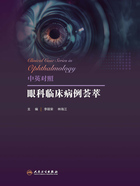
病例28 出生后61天婴儿,双眼瞳孔区变白
CASE 28 Leukocoria was observed in both eyes of an infant 61 days after birth
见图1-45。See Fig. 1-45.

图1-45 晶状体完全白色混浊伴浅前房Fig. 1-45 The lens appears completely covered with white opacif ication, with a shallow anterior chamber
鉴别诊断
Differential Diagnosis
◎ 先天性白内障:出生后立即发生的晶状体混浊。可单眼或双眼发病,可以有家族史或合并全身疾病。
◎ Congenital cataract: Lens opacif ication occurs im mediately after birth, which may be monocular or binocular.The patient may have a family history of lens opacif ication,or it may occur in association with a systemic disease.
◎ 早产儿视网膜病变:患儿低体重,可有早产史和吸氧史,双眼发生程度不等的增生性病变,严重者可发生牵拉性视网膜脱离。B超和彩色多普勒超声有助于鉴别。
◎ Retinopathy of prematurity (ROP): Children with low body weight may have a history of premature delivery and supplemental oxygen therapy. Both eyes have hyperplastic lesions of varying degrees, and in severe cases, traction retinal detachment may occur. B-scan ultrasonography and color f low Doppler are helpful for identif ication of ROP.
◎ Coats病:多为健康男性青少年,单眼发病,视网膜血管异常扩张,伴微血管瘤,视网膜下大量黄白色渗出,伴出血和胆固醇结晶的彩色反光,可继发渗出性视网膜脱离。眼底检查、B超、彩超,必要时CT、MRI检查可鉴别。
◎ Coats’ disease: This predominantly occurs in healthy adolescent boys. It manifests as monocular morbidity,abnormal retinal vascular dilation, micro a n eurysms,yellow exudation, hemorrhage, cholesterol crystals, and exudative retinal detachment. Fundus examination,B-scan ultrasonography, color f low Doppler, computed tomography (CT), and magnetic resonance imaging (MRI)may be performed when necessary.
◎ 视网膜母细胞瘤:眼部检查经瞳孔可见黄白色反光,可引起失用性外斜视,但患儿晶状体透明。B超检查有重要临床意义,可见强回声及钙化斑。
◎ Retinoblastoma: In this disease, a yellowish-white ref lection in the pupil is observed during eye exam ination,which may also be associated with disuse exotropia. The lens remains transparent. B-scan ultrasonography demonstrates strong echo and calcif ied spots, which is of considerable clinical signif icance.
◎ 永存性胚胎血管(PFV):永存性胚胎血管是胚胎期形成的血管疾病。这种情况通常发生在足月出生的孩子身上。患儿常合并单侧小眼球,伴视力低下,B超检查有助于诊断。
◎ Persistent fetal vasculature (PFV): PFV is a disease associated with persistence of primitive blood vessels formed during the embryonic stage. This cond i tion usually occurs in children born after a full-term pregnancy. Children with PFV have one smaller eye and may also have poor vision. B-scan ultras o n og r a p h y is helpful for diagnosis.
病史询问
Asking History
◎ 患儿出生时的情况,如胎龄、体重、是否有吸氧史。
◎ Asking the history of the baby’s birth, such as ge s t ational age, birth weight, history of supplemental oxygen therapy.
◎ 患儿单眼发病还是双眼发病。
◎ Whether the disease is monocular or binocular.
◎ 是否有先天性白内障病史或家族史。
◎ The family history of congenital cataract.
◎ 妊娠期间是否有病毒感染或药物服用史。
◎ The history of viral infection or other drugs taken during pregnancy.
检查
Examination
◎ 在非散瞳状态下通过直接检眼镜观察红光反射,以判断白内障的范围及对视力的影响。如果红光反射较弱,说明白内障较重。
◎ At non-dilated pupil, the red light ref lection is observed by direct ophthalmoscope to determine the scope and position of the cataract and its effect on vision. The cataract is considered severe in case of weak red light ref lection.
◎ 测眼压。
◎ Examine IOP.
◎ 散瞳检查眼底,除外视神经及眼底异常,必要时需行B超检查,除外视网膜脱离和肿物。大部分检查需要在全麻下进行。
◎ The optic nerve and retina should be examined for abnormalities after dilating the pupil. If the fundus view is obscured, B-scan ultrasonography is required to rule out retinal detachment and mass lesions. Most examinations are performed under general anesthesia.
◎ 双眼患儿建议行基因检测,并到儿科做专科检查除外相关疾病。
◎ Gene testing is recommended for children with cat aracts in both eyes. Examination should be perfo r m e d by a pediatrician for associated abnor m a lities.
实验室检查
Lab
◎ 检测红细胞半乳糖激酶活性,除外半乳糖血症。
◎ Blood examination: Red blood cell (RBC) gal a c tokinase activity (galactokinase levels) should be evaluated to rule out galactosemia.
诊断
Diagnosis
先天性白内障。
Congenital cataract.
治疗
Management
◎ 当视力受影响时应尽早行白内障摘除,随后进行人工晶状体植入或角膜接触镜治疗,以防止弱视。术后应进行系统的弱视治疗。
◎ In case of vision obstruction, cataract surgery foll o wed by IOL implantation or contact lens should be perf ormed as soon as possible to prevent amblyopia. Amb l yopia should be treated following cataract surgery.
◎ 对于影响视力尚不显著的患儿,可先行散瞳治疗以通过周边光线的射入刺激视觉发育。待患儿长大或视力影响明显时再行手术。
◎ A pupil-dilating agent may be used as a temporary mea sure to allow peripheral light rays to pass around the opacity of the lens and reach the retina to stim u l ate visual development.Cataract surgery should be per f o rmed after the patient has reached adulthood or if the visual disturbance is obvious.
◎ 单眼患儿容易导致弱视,即使未影响视轴区的光通路也应进行手术治疗,并且进行弱视训练。
◎ Amblyopia is common in children with monocular cataract.Even if the optical axis is not occluded by the cataract, surgery and amblyopia training should be performed.
患者教育和预后
Patient Education & Prognosis
◎ 非手术的婴幼儿应密切观察白内障的进展,并判断其对弱视的影响。年龄稍大的患儿弱视程度较轻,复查的间隔稍长。
◎ Infants and young children who do not undergo surgery should be closely monitored for cataract progression and amblyopia. Amblyopia is less likely to develop in older children, even if the cataract progresses. Therefore, this age group is followed-up less frequently.
◎ 幼儿白内障术后反应较成人严重,且容易出现瞳孔后粘连和继发性青光眼等,因此需要术后积极的抗炎治疗,并密切观察患儿眼压变化。告知家长,幼儿后发性白内障的发生率为100%,有二次手术的可能。另外,术后患儿常需配镜并应坚持戴镜,每半年复查调整度数,并积极配合弱视训练。
◎ Postoperative inf lammatory reaction is much more severe in premature cataracts compared with those in adults. These patients are prone to developing secondary glaucoma and posterior pupil adhesion. Therefore, active postoperative anti-inf lammatory treatment is required. IOP should also be closely monitored. Posterior capsule opacif ication occurs in 100% of cases. It is the most common complication that occurs following cataract surgery in infants. Therefore, it is necessary to explain to the parents of the children that a secondary procedure may be needed. After surgery, spectacles should be prescribed to correct aphakia, adjusted every half a year, and amblyopia training should be performed as soon as possible.